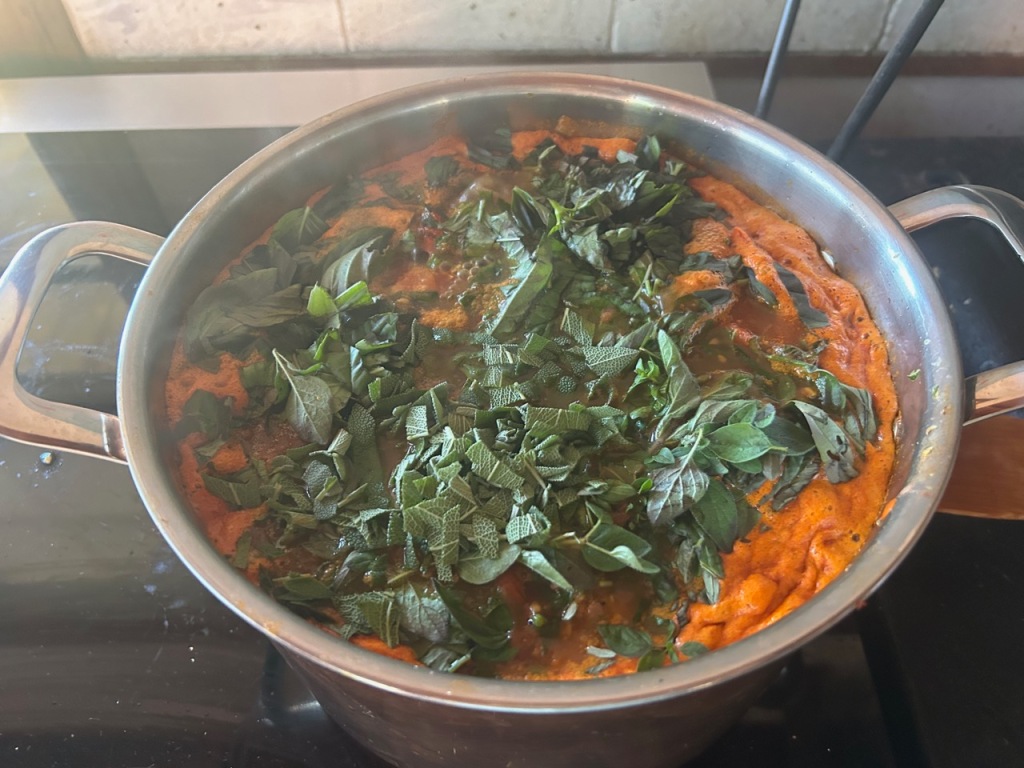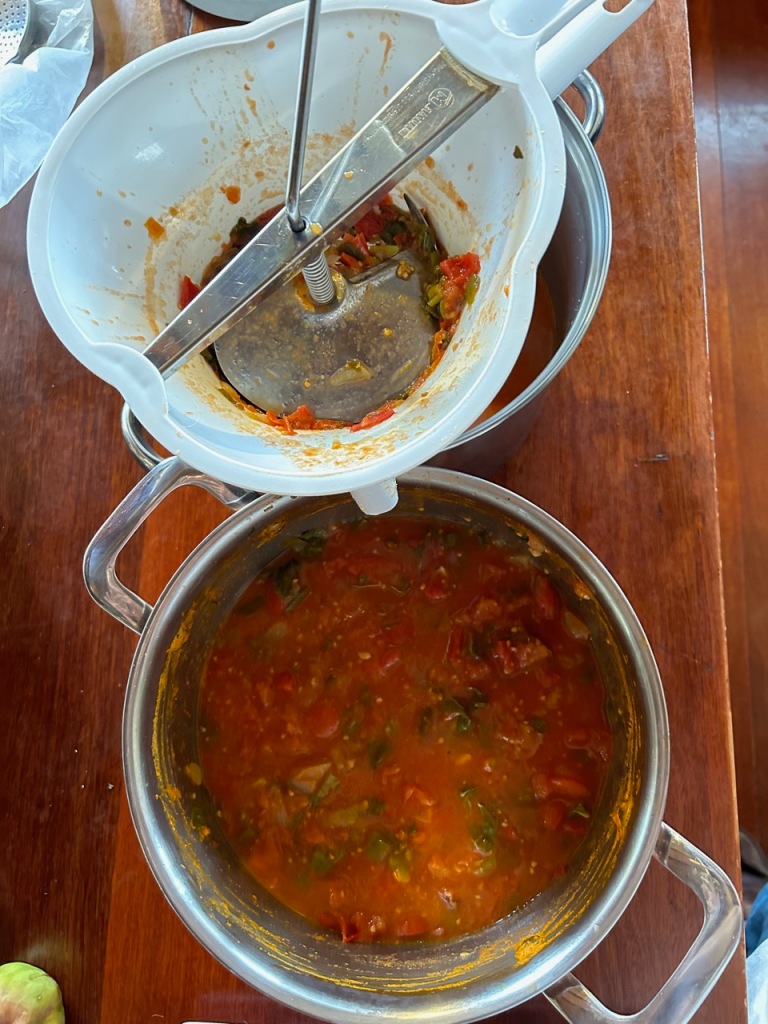We have been dealing with all the fruit and nuts that are maturing in the orchards during January. The peaches and plums are now finished. One particular peach tree has fruit that is SO fragrant that after we picked them and set the basket down in the kitchen overnight, in the morning the house was filled with the most exotic floral fragrance. This was a very beautiful experience. So simple, yet so rewarding. Sometimes it’s the most mundane and unexpressed events that leave an indelible impression.
These newly planted fruit trees in the new orchard are now 4 years old and are all recently developed fruiting cultivars, grafted onto dwarf root stocks, so they will not grow more than 2.5 metres tall. They are also all warm weather adapted, needing less ‘chill’ hours than the old varieties. Some of our older fruit tress planted over 40 years ago, had stopped setting fruit in most years, as with the increase in average temperatures due to global heating. We don’t get frosts like we used to, so they didn’t get the required number of ‘chill’ hours over winter, making the flowers infertile.
They are all growing well and are producing more fruit than we need. Previously, in the old orchard, all the trees were out in the open and too tall to net, so the birds ate most of the fruit. This new orchard is now fully netted, so we don’t share any of the fruit with the birds. Added to this, these new cultivars have been bred to carry very heavy crops. I will need to go through the orchard and thin out the crop in the early stages next season, to keep it down to a manageable level for just the two of us.
We are spending some time in the evenings, if there is anything on the idiot box, half-watching and shelling the hazel nuts. Some of the shell casing fragments end up on the floor. Janine warns me as I walk past her in bare feet, to watch out, as there are some nut cases on the floor. I reply, Yes. I’m one of them!
At this time of year, I’m certainly a nutter, so I tend to concentrate on the shelling rather than the on-screen rubbish. As the trees mature year by year, some were burnt to the ground by the fire, the hazelnut crop gets bigger. It will take a dozen evenings to get all the shelling done. So far we have de-skirted all the nuts, then put the shell out to dry for a week or so. Now we are starting on the shelling. A couple of evenings of shelling reduces a wicker basket full of nuts to one bowl of kernels. These then need to be roasted in the oven to bring out the true hazelnut flavour that we all know. After roasting, the result is about 700 grams of nuts ready to eat. Quite a bit of effort for such a small amount of nuts. We could buy them for a few dollars! But that is not the point. We don’t live and work like this for money. This is just a small part of our experiment in living a self reliant life of minimal consumption in a carbon constrained and over-heating world.
Of course, it’s not all effort, there is the reward of these amazing, home grown, unsprayed, non-toxic, scrumptious nuts. They will keep for months like this, but don’t usually get the chance, as they are too delicious.


The hazels on the left are roasted and ready to eat, but haven’t had their ‘paper’ shell coating removed as yet. On the right side are the roasted ‘cleaned’ nuts.
The vegetable garden has started to produce baskets filled with tomatoes every few days. I have just made the first batch of passata from the first three baskets full of tomatoes, 8 litres after sieving through the moulli to get all the skins and a lot of the seeds out. This made 10 bottles in this round, but there will be a lot more to come if this weather keeps up with the warm and wet conditions?
I usually grow a few old fashioned varieties of tomatoes. They are solid, firm, fruits with few internal spaces more flesh and less juice. Having a mix of varieties helps to insure that something will do well, even if others don’t. Also, wild germinated plants come up when they are ready and the soil temperature and moisture levels are right.
I also grow a few Grosse Lisse plants and some little gourmet salad varieties that come back up from self-sown seed each season. There are always plenty of them coming up everywhere, so if they are growing in the wrong place. I just weed them out, but if I can work around them, then they get to stay and be productive.

Rouge de Marmande

Mortgage Lifter

Beefsteak




In between all of this, we’ve been back in the pottery during the hottest part of the day. We had a special sgraffito workshop for all the local artists, who usually meet in the Village Hall every Monday for an Art Class, so last week they all came here instead and decorated a tile that Janine and Ingrida, the leader of the group, had made a few days before. Later in the week, I spent a couple of days making new batches of clay for the upcoming throwing workshops in March.




The clay is all pugged once through the purple vacuum (3 1/2”. 87mm.) pug that we keep for white stoneware clay. This pug was gifted to us from a close friend who hadn’t used it for some years. It came with a name ‘Pugsly’, so we’ve keep the name. The 3 1/2” or 87mm dia. pugmill is so much slower than the larger 4” or 100mm. pugmills. It still surprises me how much difference 12mm. in dia. can make. When we use the smaller ‘Pugsly’ purple pug, it takes me 2 days to do all the pugging instead of just one day.
I wrap all the clay in plastic overnight, then the next day, I cut a small slice off the ends of all the pug sausages, and process all those small sliver ends together to make a new extruded pug of clay that is a mix of all the previous pugs from different batches. I repeat this procedure of slicing off all the ends and mixing and re-pugging, until all the clay is processed. This is my way of ensuring that all the clay that I finally pug and bag is pretty much homogeneous. The finished clay is bagged and stored in a plastic lined clay box to keep it cool and dark while it ages and sours.
When full, the clay box holds about 400 kgs of clay. I make new batches of clay when the box is half full. In this way, there is always some older, aged, clay ready to use.
After I finish pugging, I wheel all the machinery out of the way, and mop the floor until it is clean and free of clay dust. Then I wheel all the machines back into place ready for the next time.


It’s a bit of a chore to clean-up and mop the floor at the end of a long day, but it has to be done to keep the workshop hygienic and workable.
And, I really like being in a clean workspace.

You must be logged in to post a comment.